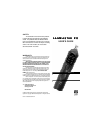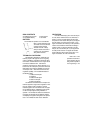
BOX CONTENTS
• LanMaster 20 Link Tester • RJ-45 Coupler
• 9 Volt Alkaline Battery • User Guide
BATTERY
The LanMaster 20 operates on one 9 volt alkaline
battery. Remove the battery cover
at the bottom of the unit and insert
the battery with the terminal
orientation as shown. Battery
polarity is marked on the back of
the battery cover and inside the
battery well for reference.
TECHNICAL OVERVIEW
The IEEE 802.3u Standard for 100baseTX (Fast
Ethernet) requires LAN equipment to use a signaling
system to establish a Link between two devices called
Link Partners. Standard Ethernet uses a single Normal
Link Pulse to establish the Link. Fast Ethernet
equipment (and some recent 10baseT products) use a
burst of Fast Link Pulses(FLPs) to transmit a Link Code
Word defining the configured capabilities of the device
and to report faults . If both Link Partners have Auto-
negotiation capability, a Link is established based on
the following priority:
1. 100baseTX Full Duplex
2. 100baseT4
3. 100baseTX Half Duplex
4. 10baseT Full Duplex
5. 10baseT Half Duplex
The IEEE 802.3u Standard does not require Fast
Ethernet equipment to support Auto-negotiation or more
than one 100baseT mode of operation. New and
installed equipment can have different levels of support
for Fast Ethernet features. Additionally, these features
can be manually configured during installation or
operation. The LanMaster 20 detects and decodes the
Link signals on Standard and Fast Ethernet networks
and displays the equipment configuration and reported
faults. The LanMaster 20 does not test 100baseT4.
OPERATION
Insert the LanMaster plug end in to the RJ-45 port
of a hub, switch, network interface card, wall outlet, or
attach to a UTP or STP cable with the RJ-45 coupler
and press the “TEST” button. Wire pair 3,6 (Link signals
from the network) is scanned for two seconds. If Link
signals are detected, the indicator(s) for the operational
modes or fault condition are illuminated and testing is
complete. When no signals are detected on the first
wire pair, the unit scans wire pair 1,2 (Link signals from
the node) for two seconds. Link signals are decoded
and the indicator(s) for the modes or fault are lit. If no
signals are detected, “NO LINK” is illuminated.
When two or more
operational mode indica-
tors are activated, the Link
being tested is capable of
Auto-negotiating to the




